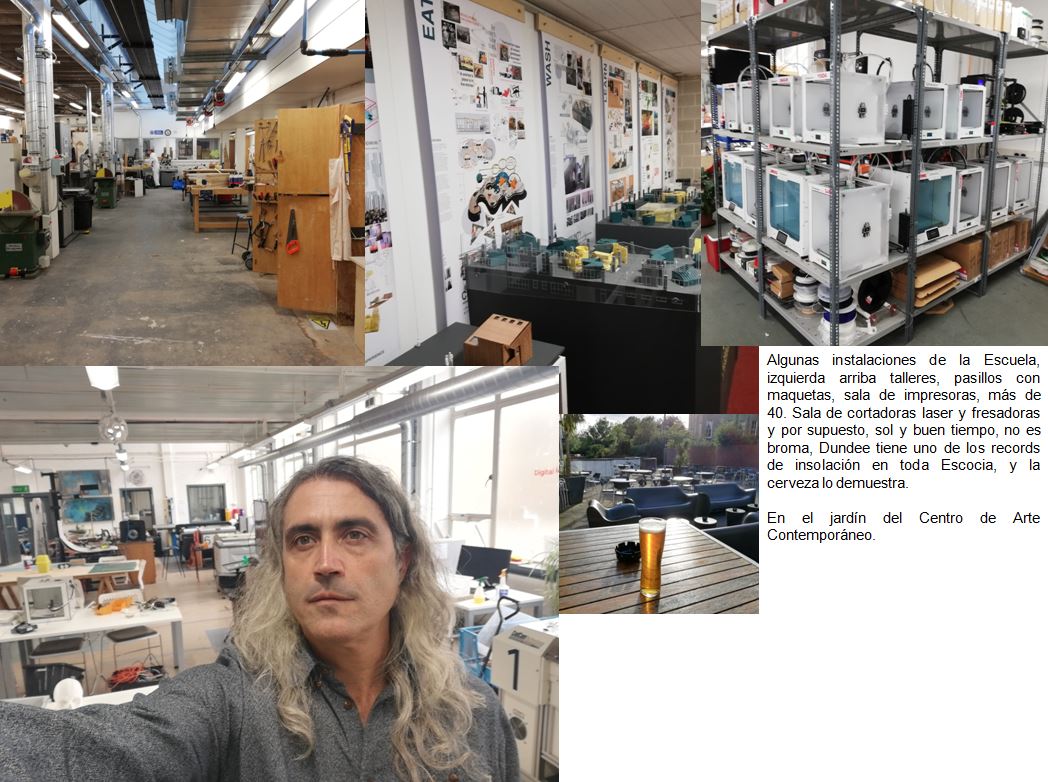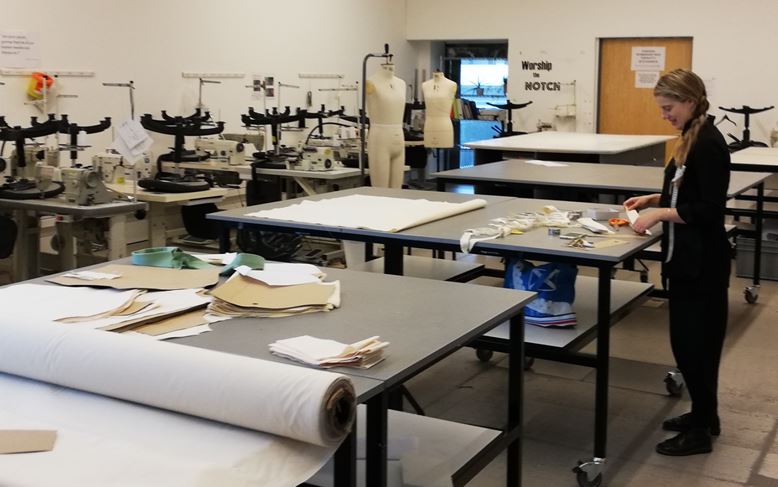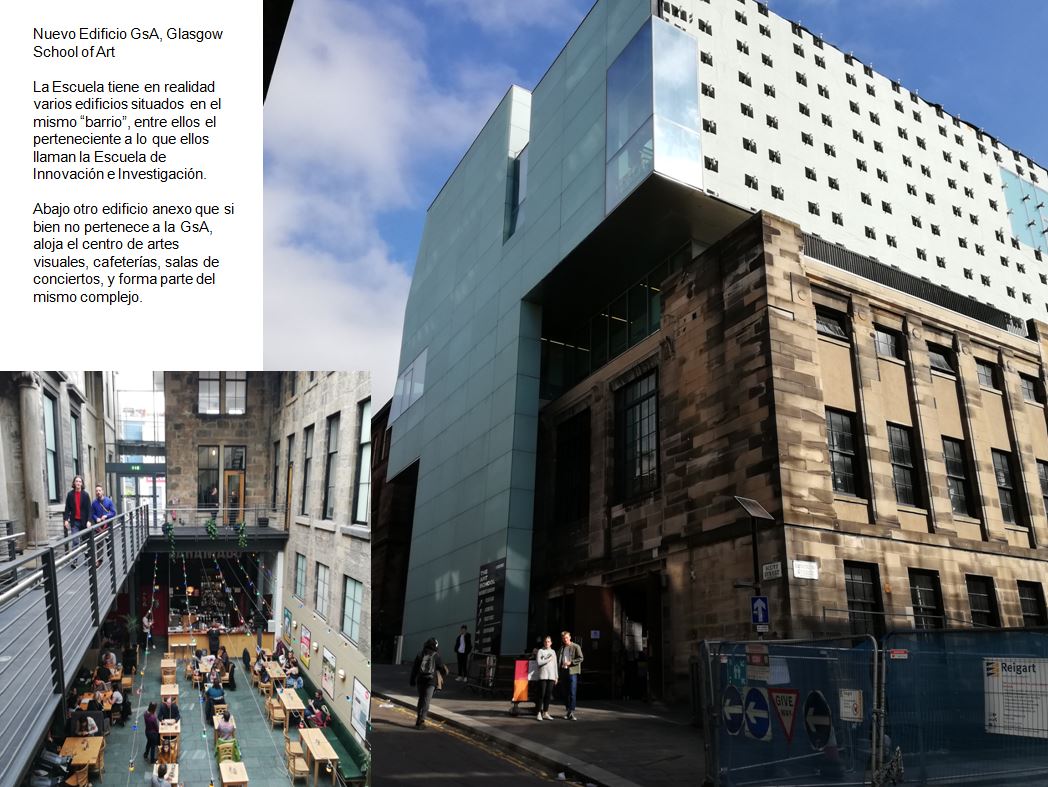




Erasmus+ Programme
Teacher: Francisco Javier Serón Torrecilla
Mobility STT_ stay: 5 days
The stay took place during the first semester of the 2019-20 academic year in two different design education centres. I spent two days at Duncan of Jordanstone College of Art and Design in Dundee and the remaining three days at Glasgow School of Art.
In both cases they are Art and Design centres attached to their respective universities, Glasgow University and Dundee University.
In both cases I was welcomed by the directors of the Erasmus programmes at the host institution, or alternatively by the Directors of the Product Design Programmes.
In the following points I will relate the experience at the academic level, as well as the immersion in the culture, the city and the country.
1.- Duncan of Jordanstone College of Art and Design
The college or School of Art and Design is located in the City of Dundee, north of Edinburgh and approximately one and a half hours by three from Glasgow.
Dundee is the fourth most populous city in Scotland after Glasgow, Edinburgh and Aberdeen. All four cities have design centres, the most renowned being Glasgow, Edinburgh and Dundee.
Dundee is a medium-sized city with a population of 150,000, but it has reinvented itself as a creative industry from its industrial past and at the beginning of the century based its activity on a material such as jute (Verdan Work Museum).
Despite its average size, it is an active centre for international students, with two university education centres and a third, highly prestigious centre, St Andrew's University, on the other side of the estuary.
On a cultural level it presents centres and museums of all kinds: The Science Museum, The Dundee Contemporary Art Gallery, the Dundee Dance Factory, The McManus Dundee's Art Gallery & Museum, the Victoria and Albert Design Museum at its Dundee site, and the Dundee Museum of Design.
The School is home to over 1,500 students, and in recent years has become one of the UK's leading schools.
Thus, between prestige and cultural activity, Dundee has been declared a UNESCO City of Design, the first in the UK.
1.1 Academic Activity
The School's initial contact was made with Chris Lim, Director of Product Design Programmes.
A few days before my arrival, Chris informed me that he would not be able to be present during my stay as he had to travel to New Zealand and was leaving on the same Monday that I started my stay at the School.
However, he kindly offered to meet me for coffee, as I was arriving in the city on Saturday.
We had a meeting on Sunday morning at the V&A Design Museum and for two hours we discussed general issues of the political context and the programmes being developed at the school and in particular how in recent years Product Design has adopted a more service design perspective through collaborations with institutions of all kinds, public and private, such as the Bank of Scotland and public health institutions.
At the same time, there is also a development of programmes linked to technology and interactivity. Given the perspective that brings us closer on this point, but as far as Service Design is concerned we are working with CADI, the possibility of being able to work on bilateral programmes was seen and we refer to future on-line meetings to assess these possibilities.
The meeting was very pleasant and we had a very fluid communication in which I was able to get a very good impression of the School, its operation and also of the city of Dundee, as Chris put me in touch with resources to enjoy the city extensively and in particular an interactive map that has been developed by the school itself or students of the school to highlight the tourist potential of the city.
On the negative side, and as we discussed with Chris, the UK's process of breaking away from the European institutions may make future agreements within the Erasmus programme more difficult, pending the conclusion of negotiations on the future of UK-EU relations.
In any case, Chris had already arranged and put me in touch in advance with one of his department colleagues, Martin Skelly, from the same department and a specialist in creative speculative design research and exploring future alternatives for emerging technologies. He regularly works with the product research studio and collaborates regularly with the Mozilla Foundation and the IoT product studio. A network of experimenters exploring the health and responsible approach to the internet of things.
Martin welcomed me on the first day of my stay at the School and introduced me to some of his colleagues in the department such as Fraser Bruce, Director of the Master's programme in Product Design with whom we discussed the relevant courses and how they are set up in Scotland.
At that meeting he made a presentation to various faculty members in the department including Martin, Fraser, Polly Duplock, head of the digital design and social academic group and Andy Milligan, Programme Director for Environmental Design. In Andy's case, he was very interested in the Strategies Masters programme that we run in the School and we chatted throughout the morning.
In the second part of the morning Martin showed me around the facilities. The School building is from the 60s and 70s and is connected on one side to the main street that links the student area, both study and leisure, and the campus buildings that run from the main street, Perth Road, inwards. The rooms are spacious and well-lit and allow for cooperative and group work. The workshops, sharing design and art specialisations, are very well equipped. In Product Design and in what we can call the fabrication laboratory I was very kindly assisted by the technician in charge of the facilities.
They have at least more than 40 3D printers, 10 laser cutters and two CNC milling centres of different sizes and types, as well as other processing centres for electronic developments.
The task of the technical manager is to have all the equipment and consumables ready, as well as to be able to assist students in the technical implementation of their proposals and to organise the use of the facilities.
Since the facilities are quite large, the day was spent visiting and getting to know all the spaces. At the end of the day Martin told me that they were still receiving the students and that the programmes formally started the next day.
He invited me to participate in a project in which more than two hundred students of Product Design, mainly interior design, are integrated, and for a whole week they have to generate a "product" that this year was linked to the centenary of the Bauhaus, I gladly accepted.
The rest of the day was spent visiting the university campus and visiting some of the city's attractions, such as the Dundee Centre for Contemporary Art.
The second day began at 9.30 a.m. with a presentation by Polly Duplock, who to all intents and purposes was the Rector of the School and who, through a presentation, organised the students in a sort of hallway where many of the teachers were present.
The organisation consisted of grouping ten to twelve students who, tutored by a teacher, would develop a proposal to present it on the last day of the week, Friday. Throughout the different days, the teachers and experts offered a long programme of different sessions, seminars and workshops with creative methodologies in the style of the Bauhaus, for example meditation sessions.
Martin encouraged me to join one of the groups, but I had to decline as I had to travel to Glasgow on Tuesday afternoon before the end of the session to join the academic stay at the GsA.
In conclusion, I was able to appreciate the excellent programmes and professionals being developed at the School and the number of students, including a large number of foreign students.
As with Chris Lim, with Martin, given the similarities in terms of interests and the programmes he develops, and in particular the speculative design programmes, we agreed to continue contact in order to explore joint work between the two schools.
2.- GsA. Glasgow School of Art
The Glasgow School of Art and Design, like Dundee, is one of the leading institutions in the field of design education and research and is recognised throughout the UK and the world.
It is affiliated to the University of Glasgow, which allows it to develop doctoral programmes, although it has a certain degree of autonomy in this respect.
It occupies several buildings in the city centre and a few kilometres from the university campus. The main building is one of Charles Mackintosh's most representative constructions. Unfortunately in successive fires in 2014, 2018 and in recent years it is currently unusable and undergoing restoration, a process that will take many years given the level of deterioration. The new building was programmed in 2009 and opened in 2014, developed by American architect Steven Holl, a modern, hyper-connected, functional building, though not as functional as my guide pointed out to me.
The School of Art is located in a bustling, lively city, full of museums of all kinds, music, pubs and cultural centres. The centre of Glasgow has a population of around 500,000 inhabitants, slightly less than Zaragoza, with the conurbation or Greater Glasgow reaching 2 million inhabitants, which makes it a very dynamic city to which many foreign students flock. Glasgow has undergone a very important change, becoming a city of creative industry, services, tourism, being in some cases at the level of London.
In this context, on the first day I was received by my contact at the School, Gordon Hush, a priori responsible for the ERASMUS programme and the Product Design programme, but who after the first contact made it clear to me that he was currently the Director of the School of Innovation and Research, a centre that is located within the School itself and which is one of the four or five research and innovation centres that the School has.
Having clarified this issue, the first day was devoted to a tour of the facilities, both the Reid building, the new headquarters of the school designed by Holl, and other annex buildings and the headquarters of the School of Innovation, given that the GsA itself is a campus in itself distributed in different spaces, since it has approximately 2000 students, many of them from abroad.
Gordon facilitated my access, given that in general, as I have seen in different schools in the UK, you cannot gain access unless you have a card, a temporary card that was given to me at the entrance.
We visited the school and there he gave me a glimpse of those wide-open spaces, not without an acid humour towards something very common, the lack of functional foresight in architecture, something shared.
One of the highlights again was the workshops. As was the case at the Dundee School, and given that it shares arts and design studios, the fabrication laboratories and workshops are particularly well equipped and spacious.
In these spaces I had the opportunity to talk to several of the technicians who are in charge of the maintenance, use, organisation and punctual support to the students, but as he told me with that Scottish humour, they are not there to solve the problems of the projects, but to give technical support.
During the first day, in addition to visiting the main space of the School, Gordon introduced me to several colleagues in the School of Innovation and Research, which is located in a building in a street a few blocks away from the main building, which was initially decided for the project and has already been intervened to host different programmes that work together from that perspective.
Product design, interior design, master's programmes and doctoral programmes, a space on two floors, with a raised floor that is arranged in different shared tables for cooperative work.
He also explained to me that they have a branch of the school itself on the highlands campus and that in this case it is dedicated to implementing innovation programmes with its own social and cultural context.
The day ended with a presentation, this time by the Director of the Product Design Programme, and it was agreed that we would have a talk in the coming days.
The rest of the day was spent visiting places such as the Contemporary Art Gallery, attached to the School building, and strolling around the city and along the Clay River.
On the second day I had an appointment with Stuart Bailey, Gordon facilitated the contact because of my interest in some of the aspects he works on. Stuart combines science, technology and design practices in a multidisciplinary way, having graduated in Physics and later studied Product Design.
He is currently the programme leader for the Product Design Engineering Degree and Master's Degree and primarily for the user-centred design social research programme. One of the application and collaborative projects "Innovating Patient Care: a human-centred design approach" working together with the Queen Elizabeth Hospital Campus Teaching Learning Centre in Glasgow on a programme of service innovation in healthcare.
We were able to talk about their programmes, programme development and their students, among whom I happened to have a product engineer from Zaragoza who had taken the master's course last year. She provided me with a lot of information and a few books.
The same morning I had contacted another teacher, Rachel Sleight, an expert in sustainable processes and materials at the School of Innovation, and we had a chat after I finished with Stuart, which was a little shorter than expected as Rachel had an engagement. In this chat she educated me on incorporating sustainability variables into the programmes through the materials and we agreed to meet on Friday. Unfortunately, she told me on Friday that she was busy with several meetings, as they were starting teaching at that time, as had happened in Dundee.
The rest of the day was spent visiting the city and its sights.
On Friday, as we had arranged, I met with the current Programme Director of the product degree at the School of Innovation, Irene Bell. Interestingly Irene pointed out to me that her background was in the ceramic product field and that over time she has moved into this role, and together with Gordon, they coordinate the School of Innovation's programmes and product design research.
For two hours we were able to chat about the particularities of their programmes and our programmes, it was very instructive. At the same time, he introduced me to a French student who, as part of a European programme, is developing his PhD programme. The rest of the day on Friday, before leaving, I visited the museum of education, designed by Charles Mackintosh and the lighthouse, the first building planned by the architect and which now houses both a collection of objects, models and designs by the architect and the Scottish Centre for Design and Architecture, among which is a space for a library of materials dedicated mainly to sustainable materials.
3.- Final reflection
I would like to emphasise that I was particularly well received by all my hosts, from whom I was able to learn a lot about the workings of their fantastic design schools and programmes, despite the language difficulties.
Although communicating in English is difficult, the Scottish accent requires special attention and at many points I had to reconnect in order to understand many of the things they were communicating to me. Despite the difficulties, it is worth opening new contacts with these institutions which are at the forefront of design in Europe and the world.
We will continue to explore contacts at the expense of what will be decided in relation to the UK's exit from the European Union.
